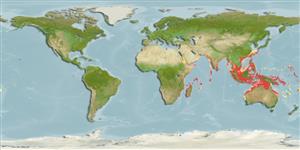Environment: milieu / climate zone / пределы глубины / distribution range
экология
морской; солоноватоводный демерсальный; амфидромный (Ref. 51243); пределы глубины 10 - 100 m (Ref. 12260). Tropical; 30°N - 30°S
Indo-West Pacific: from India to Papua New Guinea; north to Japan; south to Australia,
Length at first maturity / Size / Вес / Возраст
половая зрелость: Lm 9.4 range ? - ? cm
Max length : 23.0 cm TL самец/пол неопределен; (Ref. 12260); common length : 15.0 cm TL самец/пол неопределен; (Ref. 5450); наибольший возраст (опубликованны данные): 2.30 годы (Ref. 4544)
колючие лучи спинного плавника (общее число) : 8; членистые (мягкие) лучи спинного плавника (общее число) : 16; колючие лучи анального плавника: 3; членистые (мягкие) лучи анального плавника: 14; позвонки: 24. This species of the Leiognathus splendens complex is distinguished by the following characters: no scales on cheek; anterior dorsolateral body surface almost completely scaled without a semicircular naked area on nape; lower margin of inner preopercular ridge is smooth or weakly serrated (including the neotype); interspace of pelvic keels without scales; second spines of dorsal and anal fins are robust (width of second spines of dorsal and anal fins 0.87-1.6% of SL and 0.76-1.7% of SL, respectively); a jet black blotch on spinous dorsal fin (Ref. 75583).
Body shape (shape guide): short and / or deep; Cross section: compressed.
This schooling species inhabits coastal waters. It feeds on fish, crustaceans, foraminiferans, and bivalves (Ref. 5213). The annotated bibliography of Leiognathidae by Pauly and Wade-Pauly (Ref. 4961) includes 172 references pertaining explicitly to Leiognathus splendens.
Lipid stored in muscles, liver and intestine decreased during gonadal maturation and following spawning (Ref. 3655).
Kimura, S., T. Ito, T. Peristiwady, Y. Iwatsuki, T. Yoshino and P.N. Dunlap, 2005. The Leiognathus splendens complex (Perciformes: Leignothidae) with the description of a new species, Leiognathus kupanensis kimura and Peristiwady. Ichthyol. Res. 52 (3):275-291. (Ref. 75583)
Статус Красного Списка МСОП (Ref. 130435: Version 2025-1)
Использование человеком
рыболовство: коммерческий
дополнительная информация
инструменты
Специальные отчеты
Скачать в формате XML
ресурсы в Интернет
Estimates based on models
Preferred temperature (ссылка
123201): 24.8 - 29.1, mean 28.1 °C (based on 1680 cells).
Phylogenetic diversity index (ссылка
82804): PD
50 = 0.5625 [Uniqueness, from 0.5 = low to 2.0 = high].
Bayesian length-weight: a=0.01995 (0.01578 - 0.02523), b=2.96 (2.90 - 3.02), in cm total length, based on LWR estimates for this species (Ref.
93245).
Trophic level (ссылка
69278): 2.9 ±0.38 se; based on food items.
Generation time: 1.2 (1.0 - 1.4) years. Estimated as median ln(3)/K based on 22
growth studies.
устойчивость к внешним воздействиям (ссылка
120179): высокий, минимальное время удвоения популяции до 15 месяцев (K=0.33-1.60; tm=1; tmax=2.3).
Fishing Vulnerability (Ref.
59153): Low vulnerability (15 of 100).
🛈
Nutrients (Ref.
124155): Calcium = 301 [127, 1,001] mg/100g; Iron = 1.94 [0.82, 4.73] mg/100g; Protein = 18.3 [16.3, 20.6] %; Omega3 = 0.231 [0.128, 0.423] g/100g; Selenium = 125 [48, 357] μg/100g; VitaminA = 4.78 [0.90, 27.87] μg/100g; Zinc = 2.33 [1.09, 4.14] mg/100g (wet weight); based on
nutrient studies.
